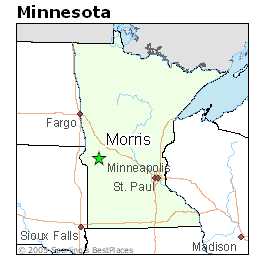 The Stanton House in west Morris looks as grand today as when it was built in the late 19th Century. (Photo by B.W.)
The Stanton House in west Morris looks as grand today as when it was built in the late 19th Century. (Photo by B.W.)"Now he belongs to the ages."
- Edwin Stanton, U.S. secretary of war, giving a famous quote at the time of Abe Lincoln's death
The Stanton House is a landmark that greets you when you drive from Pacific Avenue to West Wind Village (WWV).
West Wind Village was known for years as the Villa of St. Francis or "the Villa." Many people still say "the Villa" when they want to make it clear what they're talking about. A name change is slow to establish itself in a small town.
"West Wind" has been established long enough that it's beginning to take over in casual references. "West Wind Village" is a little cumbersome at four syllables compared to the old, simple "Villa."
But when it comes to cumbersome references, nothing can top "West Central Research and Outreach Center." The desperation for a shorthand reference led to "the Rock." That's based on the last three initials of "WCROC."
The initials are cumbersome just like the full name. A more snappy name for the place might have advantages even if it's not as descriptive.
"The Rock" used to be the West Central Experiment Station. The older name rolls off the tongue easier.
The WCROC office building is new and was built across the road from the Horticulture Garden. To the south of the garden are the wind turbines that are growing as symbols of Morris. I have described them in the past as our version of the Gateway Arch (St. Louis).
Finding West Wind Village (the Villa) is hard if you're not familiar with west Morris. It can be hard even if you're familiar with the community.
Glen Helberg lives along Pacific Avenue and he used to have his own homemade sign pointing people to WWV. Unfortunately he was directed to take that down, apparently due to wishes expressed by WWV (through legal channels).
The person who communicated this to Glen did so apologetically, I'm told. But nothing is too trivial for legal intervention, I guess.
Mow two inches over on your neighbor's property and you might be in trouble. I guess there ought to be a tall grass and weed strip along property lines everywhere.
This kerfuffle is a hypothetical - it has never happened to me - but I have heard a story about this involving a downtown business. Someone got a letter from someone's lawyer.
"They didn't have to talk to their lawyer," I heard an exasperated person say.
Alas we can never rule out such intervention.
People who habitually go to WWV will learn their way with certain landmarks. People who rarely go there or who are - horrors - from out of town could well struggle.
WWV is on the western edge of Morris. West Morris is very residential in complexion, where one block blends into the next.
Park Avenue is an artery that goes way back in Morris history. The Stanton House is on Park Avenue. You will face it directly as you drive toward WWV. You will veer a little as you go through the intersection next to the house.
Streets weren't designed at perfect right angles to each other over there. Park Avenue does not seamlessly blend in. This is a sign that it has a history much older than the rest of that part of town.
Today the Stanton House is surrounded by many other homes. It still stands out to be sure. But it must have truly been a grand landmark in the earliest decades of its existence, when the development was less.
One can imagine horses parading down Park Avenue.
The mansions of the 19th Century were built with a "fortress" sort of outlook. The outside world was seen as having dangers.
As with many old landmarks in a small community, people sometimes need reminding of their significance.
The Stanton House was built in 1880. The person behind it, Lewis H. Stanton, was the son of Edwin Stanton who was President Abraham Lincoln's secretary of war.
In reading about Edwin, one wonders why his name isn't a household word just like Lincoln. It seems that Mr. Stanton was as responsible for the preservation of our Union as the president.
I believe there is an actor playing Edwin in the current movie "The Conspirator."
We'll be hearing more about the Civil War now that we're beginning the 150th anniversary of that cathartic struggle.
Anniversaries don't excite me. As an old media person I have always found them to be tedious. There is no inherent news value in something just because of the accident of an anniversary.
I have a special warning for those who wish to get excited about Civil War anniversaries. There's trouble there. That war was brother against brother.
There was no real conciliation at the end - no compromise. The northern forces crushed the Confederacy. The planter aristocrat class was wiped off the face of the earth.
The Myth of the Lost Cause grew among those southerners who survived all that. The problem with the Myth, as the word inherently implies, is that it denies reality. It deals with "what might have beens."
Public remembrances have to do with the needs and the agenda of today. The actual southern cause, which wasn't even universally felt among southerners, is dead.
All they're left with is NASCAR?
Today's anniversary stuff is just going to become an annoyance. That's because many southerners will choose to "commemorate" the war by trying to recognize the Confederacy.
It's my understanding that a past commemoration is what resulted in the Confederate battle flag symbol incorporated into some state flags. Later this became a controversy.
We want our southern brothers and sisters to simply be Americans today. Let the Civil War reside in textbooks and the like.
I used to subscribe to "America's Civil War" magazine. It's a much better way to appreciate that historic event than any school class.
Academia tends to frown on magazines like this, for reasons that I'm sure are tied to the need of teachers to feel primacy. They insist to their students that such magazines are lowbrow. Why? It's asinine. I don't want to waste another paragraph talking about it.
The Stanton House came to have two other names: "The Chimneys" and "Stanton's Folly."
Maybe the house didn't pan out as its original owners intended, for whatever reasons. Hence "folly."
A very pleasant volunteer at WWV, name of Katia Vantries, is among the inhabitants today. WWV is very nearby.
Vince Dalager used to live in the house. I was inside the house to interview two exchange students back in my corporate media days. It doesn't strike me as any type of "folly."
Lewis Stanton was one of four children from Edwin's second marriage. Edwin's first wife Mary (Lamson) died in 1844. He married Ellen Hutchinson in 1856 and they became parents of Eleanor (1857). James (1861), Lewis H. (1862) and Bessie (1863).
Lewis would have been born in the first full year of the Civil War. Is it possible Lewis was only 18 years old when he had the grand new home built here? That's what some quick math reveals.
I once heard, although I can't confirm, that he settled in Morris because of falling ill while traveling. Morris legend has it that the town appealed to him. It's nice to believe that.
I heard the accent on chimneys was health-related.
I hope the Stanton House stands well-preserved and maintained for many more years.
Click on the link below to see a vintage photo of the Stanton House, in its 19th Century glory:
It's interesting we have two landmarks here that are closely tied to the Civil War, considering how far to the west we are.
I have written two posts previously about the other landmark: the Sam Smith statue at Summit Cemetery.
Click on the link below to see my photo of that statue:
The Civil War never fades for long in our collective consciousness as Americans. The guns are silent but there's still conflict.
We can hope all this anniversary stuff doesn't fan flames. But it could.
We hear today that Mississippi Governor Haley Barbour has refused to condemn a proposal to honor Nathan Bedford Forrest with a license plate. Forrest was a Confederate general and post-war became a leader of the KKK.
I should note here that the KKK issue might not be what it seems. I have read that the KKK at its very inception was different from the monster it later became. At its inception its purpose apparently was to protect former Confederates from harassment.
So let's put aside the KKK aspect. It's bad enough that General Forrest led the 1864 massacre of black Union troops at Fort Pillow, Tennessee.
He was considered a great military strategist. The South needed a few more of those.
In the movie "The Horse Soldiers" (John Wayne), the townspeople in the little southern town kept saying "General Forrest is coming." He didn't, so no actor was needed to play him.
Morris can feel fortunate having such visible reminders of the Civil War as the Stanton House and Sam Smith statue.
We're not conflicted, as we're totally Union in our sympathies.
We won.
- Brian Williams - morris mn Minnesota - bwilly73@yahoo.com






















No comments:
Post a Comment